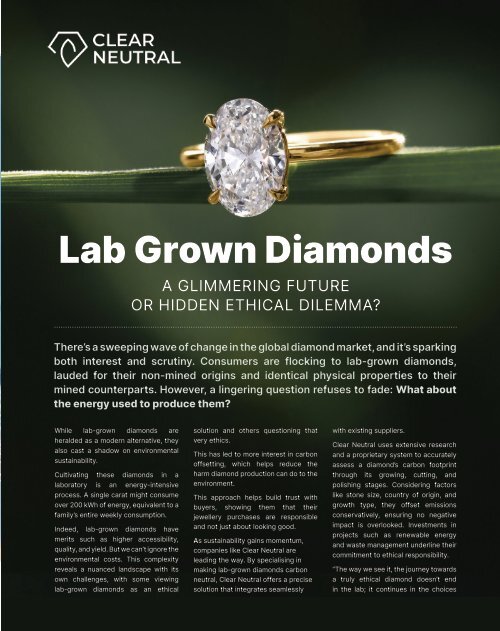Jeweller - November 2023
You also want an ePaper? Increase the reach of your titles
YUMPU automatically turns print PDFs into web optimized ePapers that Google loves.
Lab Grown Diamonds<br />
A GLIMMERING FUTURE<br />
OR HIDDEN ETHICAL DILEMMA?<br />
There’s a sweeping wave of change in the global diamond market, and it’s sparking<br />
both interest and scrutiny. Consumers are flocking to lab-grown diamonds,<br />
lauded for their non-mined origins and identical physical properties to their<br />
mined counterparts. However, a lingering question refuses to fade: What about<br />
the energy used to produce them?<br />
While lab-grown diamonds are<br />
heralded as a modern alternative, they<br />
also cast a shadow on environmental<br />
sustainability.<br />
Cultivating these diamonds in a<br />
laboratory is an energy-intensive<br />
process. A single carat might consume<br />
over 200 kWh of energy, equivalent to a<br />
family’s entire weekly consumption.<br />
Indeed, lab-grown diamonds have<br />
merits such as higher accessibility,<br />
quality, and yield. But we can’t ignore the<br />
environmental costs. This complexity<br />
reveals a nuanced landscape with its<br />
own challenges, with some viewing<br />
lab-grown diamonds as an ethical<br />
solution and others questioning that<br />
very ethics.<br />
This has led to more interest in carbon<br />
offsetting, which helps reduce the<br />
harm diamond production can do to the<br />
environment.<br />
This approach helps build trust with<br />
buyers, showing them that their<br />
jewellery purchases are responsible<br />
and not just about looking good.<br />
As sustainability gains momentum,<br />
companies like Clear Neutral are<br />
leading the way. By specialising in<br />
making lab-grown diamonds carbon<br />
neutral, Clear Neutral offers a precise<br />
solution that integrates seamlessly<br />
with existing suppliers.<br />
Clear Neutral uses extensive research<br />
and a proprietary system to accurately<br />
assess a diamond’s carbon footprint<br />
through its growing, cutting, and<br />
polishing stages. Considering factors<br />
like stone size, country of origin, and<br />
growth type, they offset emissions<br />
conservatively, ensuring no negative<br />
impact is overlooked. Investments in<br />
projects such as renewable energy<br />
and waste management underline their<br />
commitment to ethical responsibility.<br />
“The way we see it, the journey towards<br />
a truly ethical diamond doesn’t end<br />
in the lab; it continues in the choices

















